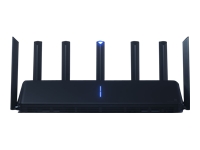-
155 faster than basic Wi-Fi 5 speeds
Mi AIoT router AX3600 offers two frequency bands of 2.4 GHz and 5 GHz, each with 802.11ax technology and without mutual interference. The two bands offer a combined dual-band wireless speed of up to 2976 Mbps. The 2.4 GHz frequency band features longer transmission for better coverage and better wall penetration performance. The 5 GHz frequency band provides low interference levels and high speed for smooth HD video playback and a smoother experience when playing large online games.
-
6-channel external high-performance signal amplifier
Two and four external high-performance signal amplifiers (PA and LNA) are installed in the 2.4 GHz band and the 5 GHz band, respectively. A power amplifier (PA) effectively increases signal transmission power, allowing the router to transmit signals farther and stronger through walls. The LNA (Low Noise Amplifier) increases the sensitivity of signal reception, allowing the router to receive a weaker signal from a greater distance.
-
With OFDMA technology to transmit data to multiple devices
OFDMA technology is one of the biggest differences between the AX3600 and traditional routers, allowing the AX3600 to send data to multiple end devices with just one transmission (up to eight end devices), whereas traditional routers would need to transmit data from multiple end devices sequentially . OFDMA enables highly efficient transfer and reduced latency so that multiple devices can be used simultaneously.
-
Enjoy high-speed Wi-Fi 6 throughout the house
Instead of dealing with dead spots from a single router, multiple mesh groups can easily handle all kinds of complex home layouts to seamlessly cover the house. In addition, you can enjoy high-speed Wi-Fi 6 wherever you go thanks to the support of the 802.11k/v protocol. The actual experience depends on the actual environment and capabilities of the user's end device.
-
BSS tinting technology significantly increases the ability to withstand Wi-Fi interference in neighboring homes
BSS coloring technology allows routers to "color" Wi-Fi by using intelligent algorithm optimization to reduce interference between different colored Wi-Fi, resulting in improved overall communication efficiency and maximum use of network resources.
-
Secure WPA3 encryption protocol that offers data security on your home network
WPA3 is a Wi-Fi security standard that introduces more complex algorithms for computer authentication, making network penetration much more difficult and keeping user data secure.
-
Supports beamforming technology for directional amplification of signals
Beamforming automatically detects the location of devices such as mobile phones and computers on the network, boosts the signal at that location, and provides effective Wi-Fi coverage in a wide range with stable signal quality.
-
Combining two frequency bands under one network name, so there's no more confusion about which one to connect to
Mi AIoT router AX3600 supports dual-band integration by combining 2.4GHz and 5GHz bands into one Wi-Fi name. Dual-band terminals can select the appropriate access band according to the current environment, so you don't need to worry about which Wi-Fi to connect to.
-
High heat dissipation for stable operation
Large aluminum alloy heatsinks and high thermal conductivity adhesives are used to cool the router, with vents located on the top, bottom and sides of the case. A metal piece is mounted on the top of the triangular-shaped body, which accelerates heat transfer from the inside to the outside, providing stable thermal support for high-speed router operation.
-
Easily manage the time your kids spend online and the content they access
Manage the time your child and family members spend online and limit their access to certain websites. Features like offline alerts for certain devices and daily online newsletters can help you learn more about your child's online experiences.
|
| Data link protocol |
Ethernet, Fast Ethernet, Gigabit Ethernet, IEEE 802.11b, IEEE 802.11a, IEEE 802.11g, IEEE 802.11n, IEEE 802.11ac, IEEE 802.11ax (Wi-Fi 6) |
| Line encoding format |
DBPSK, DQPSK, CCK, 64 QAM, 256 QAM, BPSK, QPSK, 16 QAM, OFDM, 1024 QAM, DSSS |









